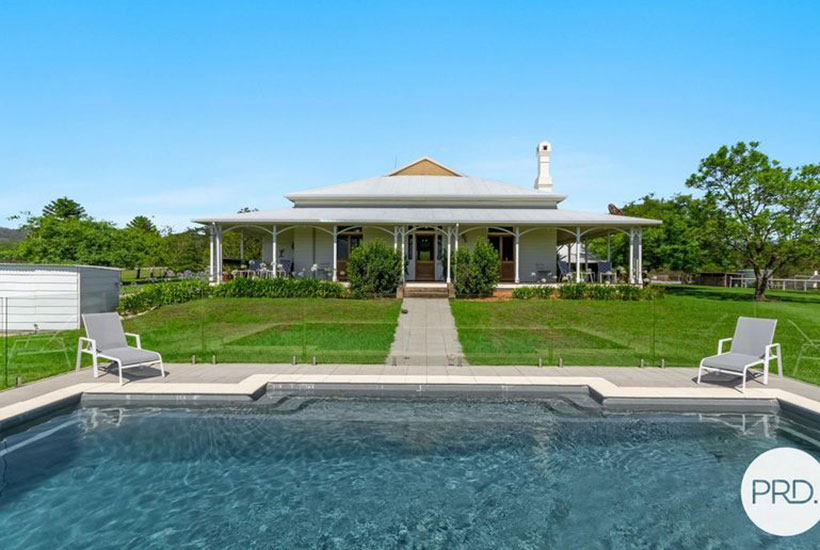Farm life an “attractive proposition” for many post-pandemic

This heritage rural New South Wales property heralds an array of agribusiness opportunities from timber to beef, for the right new owner.
As well as a beautiful, historic homestead, Emu Creek Station in Tabulam, in the Upper Clarence Valley, offers several income streams from beef grazing, backpacker farm-stay accommodation to service the local blueberry industry, as well as an established timber plantation.
Set on an expansive 782ha landholding, the property plays host to a selection of varied agribusiness enterprises, along with 6km of creek frontage, fertile creek flats and rolling pastures.
Built in 1890, the homestead has retained quaint hallmarks of its era with wraparound verandas and timber floorboards, while integrating modern conveniences including a renovated ensuite, galley kitchen and in-ground swimming pool.
The property also houses a restored slab hut, which is used as a family entertaining space and as extra accommodation.
“It’s got the beef grazing as well as backpacker accommodation and it’s got a private forestry plantation for future harvest,” said selling agent Kel Gunther, from PRDnationwide – Casino.
“You don’t have to worry about droughts and cattle prices or anything like that, you’ve got multiple income sources. It’s a very attractive proposition.”

The home at Emu Creek Station retains many of its original features. Picture: realcommercial.com.au/for-sale
The rural lifestyle is primed for remote working
Mr Gunther said the coronavirus pandemic, remote working and the roll out of improved internet connectivity via the National Broadband Network had encouraged more people to seek out a rural lifestyle while retaining city-based employment remotely.
Many were also seeking out alternative income options to safeguard their financial positions in case their 9-5 jobs evaporated in times of uncertainty, he said.
“We’re no different to any other markets at the moment – enquiry is strong and stock is short,” Mr Gunther said.
“Probably our biggest movement in the last 12 months or since COVID started has been the lifestyle market, the tree-changers.
“A lot of people I’m dealing with are not locked to an office. Over COVID so many businesses became internet based, even farming (businesses) so they’re finding they don’t have to be locked in an office 9-5, they have flexibility.
“After four years of NBN, we’re also seeing the effects of country areas really having the availability of internet that they really didn’t have five to 10 years ago.”
Strong commodity prices are driving interest in farming
NAB agribusiness economist Phin Ziebell said COVID-19 was not the only driver of success in the sector in the past year, with surging commodity prices leading the recovery and fuelling interest in agribusiness properties.
“There are a couple of key trends happening here as it pertains to property,” Mr Ziebell said. “The first is that we’ve had a good season across a large chunk of the country after some pretty rough years in some parts of Australia and that has underpinned a really good recovery.
“We have had really good crop yields in the eastern states and we have seen a lot of demand for restock of cattle. Overall, we’ve seen broadly encouraging commodity price movements. Most commodities have done pretty well.”
Mr Ziebell said the overlay of COVID on the successful year meant people were looking for food security with the trend of holding more physical grain pushing prices up.
“The RBA’s stimulus measures have cut interest rates to basically rock bottom levels, and low interest rates equals higher property prices,” he said.
“You’ve got some of the best conditions in a large chunk of rural Australia that you’ve had in property since 2016. What’s really interesting is that through the drought in New South Wales and Queensland, you didn’t see declines in rural property prices. Usually that does occur but we didn’t see that and having low interest rates is probably part of that.”

The restored hut at Emu Creek Station could be used for short-term accommodation. Picture: realestate.com.au/for-sale
Mr Ziebell said while there was a cohort of people reconsidering where they are living in Australia, he did not believe agribusiness prospects to be the only contributor.
“I don’t think that you’ve got a lot of people living in Fitzroy [in Melbourne’s inner north] wanting to go out and buy cattle stations, but there’s certainly interest from people wanting to move from city areas to regional areas and they’re changing the type of housing that they have, even renters,” he said.
“I think a lot of the talk you’re seeing around this moving from the city to the country phenomenon isn’t really about buying pure agricultural properties. It might be hobby farms, a house in town and largely close-ish to capital cities, say an hour or two away.
“There’s been a longer running trend where some of these regional towns on the rail system have already become almost dormitory suburbs of Melbourne because of connectivity to the city. You only need to look at towns like Ballarat, Geelong or Bendigo – there’s a lot of Melbourne commuting there now and that was a trend pre-COVID. The working from home thing might have driven some changes as well.”
Emu Creek Station is scheduled to go to auction on 25 February at 10.30am and is expected to fetch between $3.5 million and $4 million.









